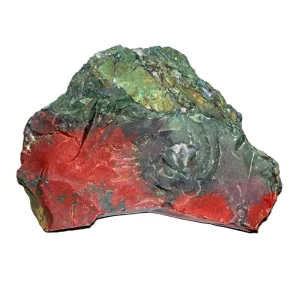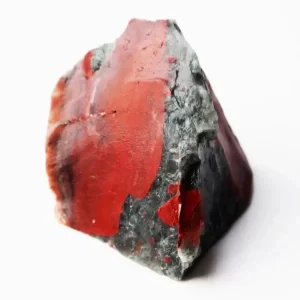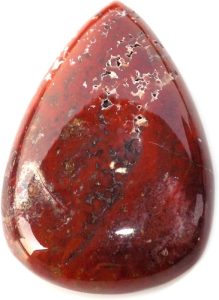
The second birthstone for March is bloodstone, a dark-green gemstone flecked with vivid red spots of iron oxide. Generally found embedded in rocks or riverbeds as pebbles, primary sources for this gemstone are India, Brazil, and Australia. Bloodstone is also called heliotrope, a word from the ancient Greek that means “to turn the sun.” Many believe it was probably named as such because of ancient ideas about how minerals reflect light. In fact, some believed that the sun itself would turn red if this gemstone was put into water.


History & Lore
ABloodstone, named for the red speckles that resemble drops of blood, is a dark green variety of chalcedony marked by iron oxide inclusions, typically hematite. In ancient times, Greek and Roman oracles and priests believed it held mystical powers, such as the ability to grant invisibility or influence the weather, particularly solar eclipses. It was used as a healing talisman to stop bleeding, cure wounds, and repel venomous creatures. Its smooth texture made it ideal for carved intaglios, signet rings, and seals. In India, bloodstone has long been a part of Ayurvedic medicine, valued for purifying the blood and energizing the body—an association that persists in traditional healing today. One of the most powerful legends surrounding bloodstone comes from medieval Christian lore, which claims the stone was formed at the crucifixion of Christ when his blood fell onto green jasper, staining it. This tale earned it the name “Martyr’s Stone” and led to its use in religious sculptures, crucifixion carvings, and rosary beads. It was also thought to protect soldiers in battle by imbuing them with courage. During the Renaissance and throughout the Middle Ages, bloodstone appeared in books of magic and alchemy. It was worn as a charm to protect against evil spirits and negative energy, used in divination to foresee the future, and even believed to grant invisibility under certain ritualistic conditions.
Meaning & Symbolism
Across history, its symbolism evolved: in Ancient Egypt, it represented strength and immortality; in Classical Greece, solar power and courage; in Christian Europe, sacrifice and divine blood; during the Renaissance, healing and mystical grounding; and in modern metaphysical circles, vitality, blood purification, and root chakra balance. Today, bloodstone remains popular in crystal healing and spiritual practices, where it is believed to boost energy, support detoxification, offer grounding and protection, and help one align with ancestral wisdom. It is also a traditional birthstone for March, often paired with aquamarine.
Origin & Location
Agate is found in South Africa, Western Australia, Brazil, Bulgaria, Czech Republic, Italy, Nova Scotia, and numerous locations in the United States.

